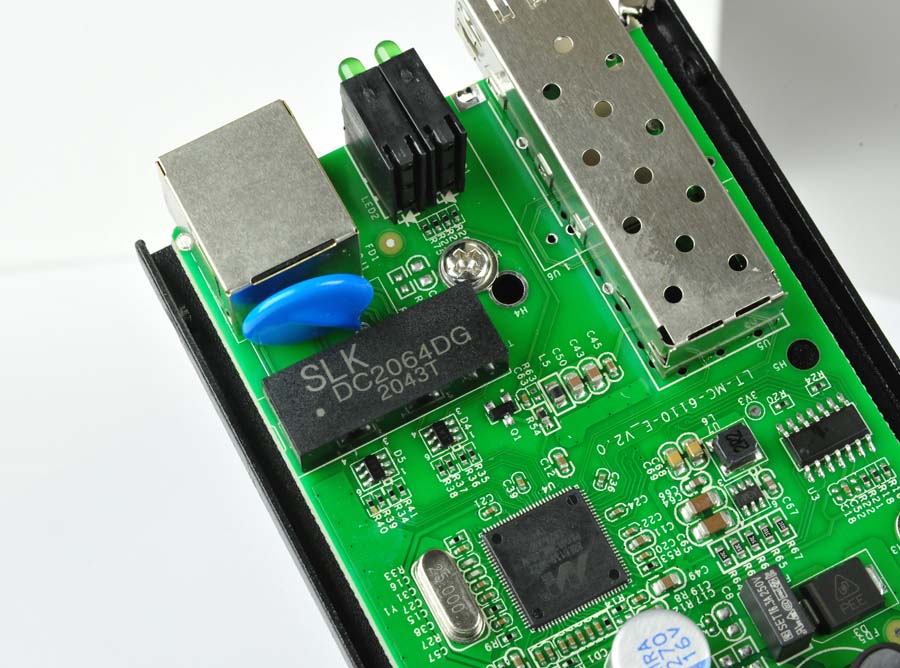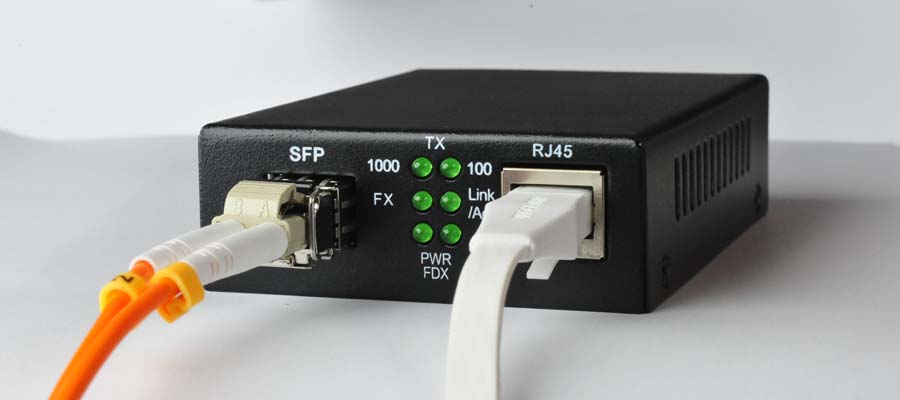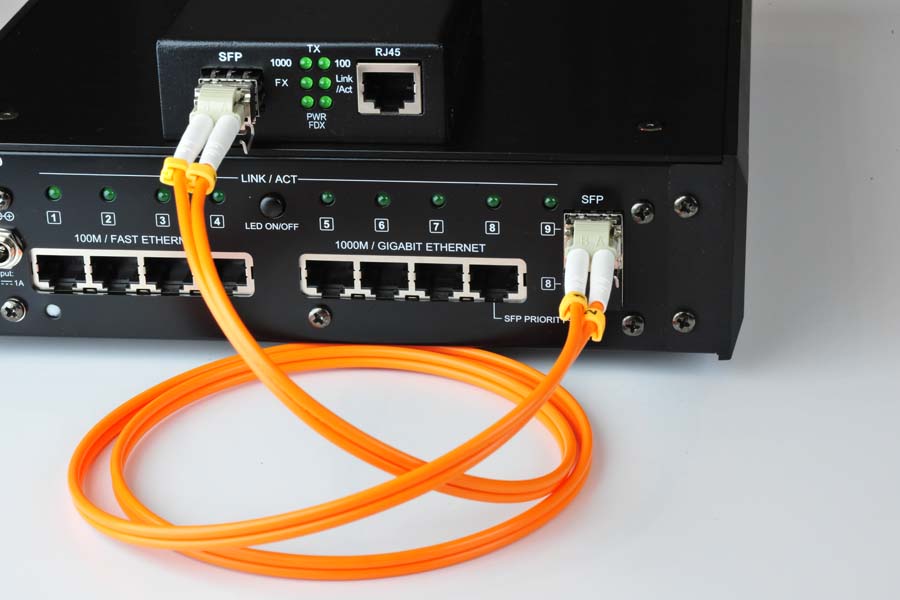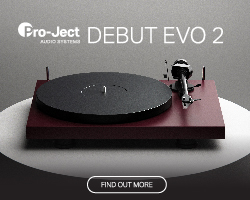ADOT MC01 FIBRE NETWORK KIT REVIEW
The ADOT MC01 Fibre Network Kit converts your ethernet signal using copper wires into a signal using fibre optics and is said claimed to have several benefits for the serious digitally-inclined audiophile. Chris Baillie takes a listen for HiFi Pig.

The ADOT kit is a small and unassuming unit.
FIBRE PROVIDER
The ADOT MC-01 is a device that converts an Ethernet signal into a fibre optic one. Anyone reading this review has probably heard of fibre optic transmission of data. Going back to the early days of connecting, for example, a CD transport to a DAC, the jury has always been out as to whether an optical connection between two domestic digital components offers any benefit over a coax copper, or even a more exotic metal connection, such as silver. My personal experience has been that coax sounds better than optical in this application. It is not surprising, therefore, that I was initially a little sceptical as to how the ADOT SFP (Small Form-factor Plugable) kit might benefit the relatively short distances involved in a domestic environment. As ever, I believe these things are down to implementation. I have always been aware that such connections break the ground loop between components and, of course, items such as router and modem use cheap PSU’s. It stands to reason to me that noise from these electrically noisy units could well end up getting transmitted to the renderer/streamer. Couple this with noise introduced from your Ethernet cables, especially if, like mine, they can’t be routed as far as ideal from mains cables, it’s not hard to understand how fibre transmission may be of some potential benefit to HiFi systems. The other benefit claimed is that the signal is reconstructed at the receiving end, apparently reducing jitter. I’ll let others fight over the whys and wherefores of each of these points, but as far as I am concerned the results I experienced were valid and convincing.
ADOT MC01 DESIGN AND BUILD
Externally, the ADOT MC01 is a generic looking small black box, one side with both SFP and Ethernet plugs, plus LED indicators of status, and the other with a 5v input and 4 small dip switches, which amongst other things, can be used to drop the output from 1GB, down to 100mps in the quest of improved sound quality. I paired the ADOT with the Melco S100 network switch and did attempt to feed it with the 100mps output, selected by flicking on switches 3 & 4, followed by power down and back up. Unfortunately, neither my Moon 280D or indeed my Chord 2Go, would work in this setting. A chat with the distributor confirmed that, indeed, the 100mps output is not compatible with certain brands, Linn being one, in particular, that is known to them. They were surprised, but not shocked at the results with my Moon and Chord streamers.
The ADOT MC-01 is available in three different configurations – Kit 1 at £349 – supplied with a basic switched-mode power supply. Kit 2 with a plug in linear power supply unit at £399 andKit 3, as an ultimate version, supplied with a PLixIR LPSU at £750. An Additional MC-01 is available, to allow the use of a device that does not have an SFP port, at £179. Kit 2 was supplied to me for the purpose of this review. A kit known as ‘MC Accessory’ which is basically a second MC-01, PSU and Ethernet cable is available for £199, to enable those without an SFP compatible network switch to take advantage of the ADOT Fibre Optic connection system.

Inside the ADOT.
SOUND QUALITY AND PERFORMANCE
I used the ADOT MC01 combination in my main system, which is, a Melco NA1/2 Server, Moon 280D Streaming DAC, Moon 600i amp, Totem Forest Signature Speakers, interconnect & speaker cables being Tellurium Q Ultrablack 2, Audioquest Vodka Ethernet between NA1/2 & Moon 280D, Audioquest Coffee USB. Supra Cat 8 cable used from router to ADOT MC-01, Chord C-Stream from S100 to the Melco NA1/2. The MC-01 as supplied needs to be paired with a compatible switch, with an SFP input, so I used the Melco S100, also reviewed for HiFi Pig.
I began listening to the S100, connected via Supra Ethernet cable rather than the ADOT, just to get my bearings. It replaced the Russ Andrews RANS-1 Switch which I recently reviewed for HiFi Pig. I liked the RANS-1 and to be honest would have been happy to keep it in the system, had funds allowed. The S100 on its own, gave a nice uplift in performance, building on the strengths of the RANS-1 but bringing more detail and greater resolution. The music had a little more life to it and the lead instruments had a little more projection. Was it worth the extra £1100 in price? In my system that is a hard one to answer, as there may well be other things I could change for similar cost that provide more. Nevertheless, I wasn’t complaining and just enjoyed the music.
Adding the ADOT MC01 enabled me to move the S100 onto my main system rack and avoided running Ethernet cables near the mains cable that feeds my TV. This situation was previously unavoidable, and so replacing the Ethernet cable with fibre optic cable, which is impervious to interference from the mains cable, was, to me, obviously desirable. Having said that, I was still surprised at the magnitude of the improvement.
If you’ve read my previous reviews of both the RANS-1 and English Electric 16Switch, one of the albums I use as a reference is ‘Rejoice’ by Tony Allen and Hugh Masekela, streamed via Qobuz at 24/96. The S100 via Ethernet certainly allowed you to better appreciate the interplay between the musicians and, indeed, the cymbals sounded cleaner and more detailed. With the ADOT MC-01 feeding the S100, the whole soundstage opened up and gave a far greater sense of dimension in all directions! Each performer was now given more space, allowing me to hear more of the contribution of each musician. The vocal chants at the start of track 1, ‘Robbers, Thugs & Muggers (O’Galajani) ’ had a greater sense of reverb. Moving to other musical choices, I was appreciating a much better sense of soundstage depth and of acoustic. Later I listened to the 2021 Remaster of Metallica’s ‘Black Album’ 24/44.1, again via Qobuz. Lars’s drums were well back in the soundstage and I was struck by how easily I was able to pick out each instrument, yet the music had real drive and was utterly involving. The RANS-1 is long gone, so I switched back to my own Silent Angel Bonn N8. Whilst still pleasant, the soundstage shrunk and I lost interest in the music very quickly. In fact a similar thing happened when a friend paid a visit several weeks ago, shortly after the S100/MC-01 arrived. We were listening to a track via Qobuz and I swapped the S100/MC-01 over for the Silent Angel, without telling him exactly what I had done. My friend commented that the soundstage had collapsed, and the music now sounded boring, so could I swap it back please!

The ADOT unit connected.
One of the things that surprised me whilst testing previous switches, was how the sound of locally stored files, fed from my Melco NA1/2, also benefitted, albeit to a lesser extent than those streamed via Qobuz. Again this was the case using the S100/MC-01 but to a much greater degree. According to Melco this is the benefit of breaking the electrical connection to the router. There was still less benefit with local files than via Qobuz, but I was still enjoying better soundstage depth and greater resolution listening to music from the Melco NA1/2, via the S100/MC-01. I can only attribute this to less noise entering the system.
Overall, I have to say the character of my system has become far more transparent, improved soundstage in both terms of depth and width and the last hint of harshness, my set up could occasionally suffer from, was removed.
CONCLUSION
As you can probably tell, I don’t just like the ADOT MC-01, I like it a lot. It has greatly enhanced my enjoyment of music and for those who already own a network switch that has an SFP input, it’s the proverbial ‘no brainer’. For those that do not own such a device, I would definitely recommend trying the MC-01 with the MC Accessory Kit, especially if you need long runs of cable from your router to your switch and indeed if you need to run that feed near power cables or other potential sources of electrical interference.
AT A GLANCE
Sound Quality:
In my set up it has improved transparency, detail, soundstage and removed harshness. Music is more involving and enjoyable to listen to with these components in place
Build Quality:
The S100 is in the typical Melco mould, which means solid and purposeful, rather than pretty. The ADOT MC-01 is built to do its job – doesn’t need to be flash so isn’t, but solid enough
Value For Money:
In terms of cost versus performance, this is definitely one of the better upgrades I have experienced in my system.
We Loved:
Lower noise floor – less grain and smoother top end.
Improved Soundstage.
More involving musical experience.
You can run fibre optic cables near mains cables without degrading sound quality.
Improves streamed video also, if that’s your thing.
We Didn’t Love So Much:
It uses up an extra mains socket, other than that, nothing!
Elevator Pitch Review: The ADOT MC-01 is a must-try for owners of network switches with SFP inputs. I am sure most owners of the Melco S100 will have it on their radar and be impressed if they try it. I would be seriously tempted to try a pair of ADOT MC-01’s even if you don’t own such a device, especially if the routing of Ethernet cables to your router to your switch, passes potential sources of electrical interference, such as mains cables.
Prices:
ADOT MC-01 Kit 1 – £349.00
ADOT MC-01 Kit 2 – £399.00
ADOT MC-01 Kit 3 – £750.00
ADOT MC Accessory Kit – £199.00

Chris Baillie
















































































































































































































